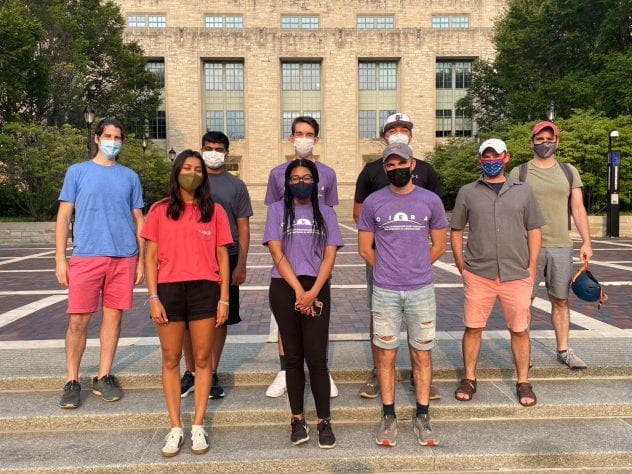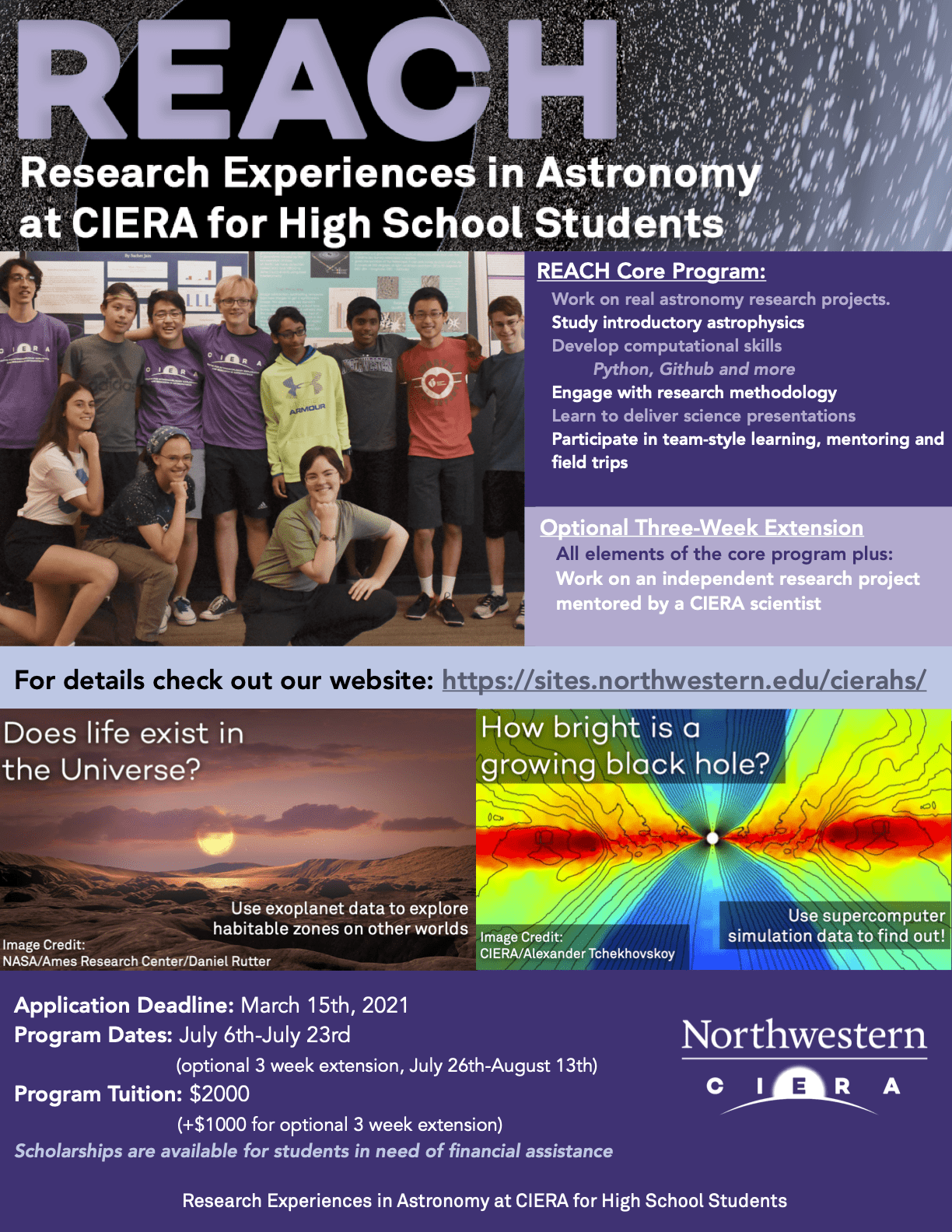2021 Program Information

Session 1
(Top to Bottom, Left to Right)
Students: Eesha Santosh, Alexandra Yao, Angela Guo, Mira Littman, Sam Sweet, Charles Petajan, Ineza Orlyse, Mason Hergert, Jacques Sevrain
Northwestern Scientists and Staff: Diego Munoz, Patrick Sheehan
Not Pictured: Sophie Lammers, Rafael Crespo, Sahaara Clark

Session 2
(Top to Bottom, Left to Right)
Students: Nihal Kaki, Andrew Kern, August Hassar, Mira Laroyia, Mia Bonds, Dean Kousiounelos
Northwestern Scientists and Staff: Nathaniel Wootton, Patrick Sheehan, Diego Munoz,
Not Pictured: Dean Cianciolo, Ian Faversani, León Garcia
Program Staff
Who are we?
Program Director: Dr. Patrick Sheehan is an NSF Astronomy & Astrophysics Postdoctoral Fellow, and has over nine summers of experience in leading Astronomy focused high school summer programs.
The 2021 research mentors and instructors are listed below:
Mentors: Howard Chen, Erin Cox, Giacomo Fragione, Monica Gallegos-Garcia, Alexa Gordon, Miguel Martinez, Jillian Rastinejad, Michael Stroh
Instructors: Deanne Coppejans, Lindsay DeMarchi, Wynn Jacobson-Galan, Emma Kaufman, Camille Liotine, Diego Munoz, Stacy Montgomery, Kerry Paterson, Sukrit Ranjan, Monica Rizzo, Kyle Rocha, Genevieve Schroeder, and Tjitske Starkenburg
Program Content
Week 1
- Learn to work with data! This includes an extensive introduction to programming and scientific data analysis with the Python programming language, with additional topics such as:
- Working with astronomical images
- High Performance Computing (supercomputers)
- Data visualization
- Learn about Astronomy! Learn about stars, planets, galaxies, and cosmology while putting the programming skills you are learning to work with hands-on computer programming activities.
Weeks 2-3
- Research projects! Put your computer programming skills to good use by working on real astronomy research projects put together by CIERA scientists from their own research interests. At the end of Week 3, you’ll get to give a presentation on what you found!
Weeks 3-6 (Extended Research Project – limited availability)
- Students participating in the extended program will conduct an independent research project with a CIERA scientist mentor. These students will work with their mentors to set daily and weekly goals as they dive deeper into astronomy research, culminating in a presentation on their work at the end of the summer.
- Meetings with cohort and program coordinator Mondays and Fridays 10am-12pm
- Daily meetings with mentor (may be virtual)
- Independent work on research project by the student, with an expectation of approximately 5 hours a day. Exact hours are flexible, and the student can opt to do much of the work remotely.
- For students working virtually, regular real-time communication with mentors and program staff will be facilitated by digital tools such as Slack and Zoom.
Additional programming scheduled throughout may include a college panel, an observing night at Dearborn Observatory, a field trip to Adler Planetarium, and more!
Research Projects
Extended Research Projects
The 2021 cohort of High School students worked on the following research projects, created by the CIERA scientists below:
Exploring Fast Radio Burst Host Galaxy Properties
Project Design: Alexa Gordon
Student: Mira Littman
Fast radio bursts (FRBs) are new, mysterious events that have only been detected with radio waves so far. In order to learn more about these events, we can study the galaxies in which they form (called host galaxies) to determine what could lead to FRBs. In this project, you will explore the brightness and colors of these host galaxies and use Python plotting tools to compare the properties of FRB host galaxies (such as mass, age, composition, and many others) to see if there are similarities or differences among the known sample of FRB host galaxies.
Polarization in Baby Stars
Project Design: Erin Cox
Student Angela Guo
Magnetic fields are everywhere in space, and we want to know how they control young stars that are only just forming. We will use data from the ALMA telescope in Chile to look at the polarization signature from young stars to figure this out. We’ll also use this data to find out basic information about these stars, such as how big they are.
Simulations and Evolution of Binary Black Holes
Project Design: Monica Gallegos-Garcia
Student: Rafael Crespo
Massive stars (>8 the mass of the sun) can become black holes. When you have two massive stars together in a binary system you can have many different and exciting outcomes. In this project you will use data from simulations of binary stellar evolution to study the formation of binary black hole mergers to understand how common different outcomes might be.
Exoplanet Biosignatures driven by Stellar Activity
Project Design: Howard Chen
Student: Alexandra Yao
Stellar activity is thought to be able to impact a planet’s atmospheric evolution, but the extent that these effects can influence the abundance of biologically produced gases is unknown. We’ll be using data and modeling tools to understand how much biosignatures can be produced and whether we can observe them with future telescopes.
Gravitational Waves from Mergers of Binary Black Holes
Project Design: Giacomo Fragione
Student: Charles Petajan
The recent discovery of gravitational waves has opened new horizons and promise to shed light on the origin of black holes. The astrophysical origin of mergers of black holes is among the most puzzling open questions of our time. We will use numerical simulations of close encounters of black hole pairs to understand under which conditions they will merge. The characteristics of the black holes that merge will be compared to the catalogs from the LIGO/Virgo collaboration.
How Much r-Process Material do Neutron Star Mergers Create?
Project Design: Jillian Rastinejad
Student: Sophie Lammers
Most of the heavy, rare elements on Earth (including gold and platinum) were formed by the r-process in astrophysical explosions. The explosions of merging neutron stars, “kilonovae”, have been observed to form r-process elements. We will use a small sample of observed kilonovae and models to determine how much r-process material was created by these mergers.
Exploring Variable Stars and the Milky Way
Project Design: Michael Stroh
Student: Mason Hergert
Stars are useful probes of the dynamics of the Milky Way. In this project, we will use new data from the Very Large Array to map the velocities of stars in the Milky Way and also look for correlations between the strength of the radio and optical emission.
Moonmoons
Project Design: Miguel Martinez
Student: Sam Sweet
An interesting question came up a few years ago: is it possible for moons to have sub-moons? Putting aside questions of formation, the student will run some simulations of orbits around moons analogous to the moons found in the solar system and diagnose their long term stability.
Program Schedule
When was it?
Dates
Session 1: July 6th – July 23rd
Session 2 + Extended Research: July 26th – August 13th
Flyer

